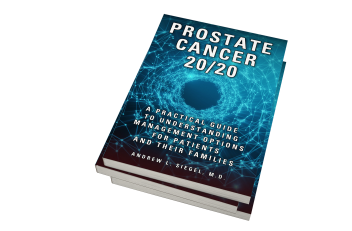Andrew Siegel MD 10/17/2020
First off, a shout out to my very close friend Andrew Schwartz. We met in 1981 as surgical interns at North Shore University Hospital and have been like brothers ever since. After general surgery residency, I trained in urology whereas Andy trained in cardiac surgery and he ultimately segued into hospital administration, becoming chief medical officer of a hospital in Myrtle Beach. Unfortunately, Andy was diagnosed with pancreatic cancer this past February. He is undergoing chemotherapy and doing quite well with imaging studies showing tumor shrinkage and blood tests showing a significant improvement in his tumor markers. Andy has an energetic optimism and is in the process of sharing his unique insights from the perspective of both surgeon and patient via a blog named fight of my life and I encourage readers to check it out and share it with anyone you feel would benefit. His desire is to create a forum for the exchange of emotions, concerns, stories of success and disappointments and to drive home the expectation that no one should deal with illness alone. Thank you.

Caruncle is a mysterious term, an odd combination of car and uncle. It derives from the Latin caruncula meaning wart and can refer to different things–the warty protuberances on the head of a turkey (bird caruncle), the red prominence at the inner corner of the human eye (lacrimal caruncle), and a fleshy structure attached to a seed (plant caruncle). Forget about turkeys, eyes and seeds, as the topic of today’s entry is the urethral caruncle, a not uncommon finding of the opening of a female’s urethra (the channel that conducts urine from the bladder).
A urethral caruncle typically appears as a benign, red, inflammatory, variably-sized polyp of the post-menopausal female urethra. Although often asymptomatic and merely a finding on pelvic examination, it can sometimes bleed and cause painful urination or painful sexual intercourse.
WHY DO URETHRAL CARUNCLES OCCUR?
They typically occur because of low estrogen levels resulting from cessation of ovarian function at natural menopause, or alternatively, from surgical menopause from ovarian removal, or medically-induced menopause. The urethra (like the vagina) has estrogen receptors and after menopause decreased estrogen stimulation results in atrophy and loss of tissue elasticity, suppleness and integrity, a setup for the formation of these benign inflammatory polyps.
SYMPTOMS
Most of the time, caruncles do not cause any symptoms whatsoever and are recognized at the time of pelvic examination. At times, patients with caruncles present with a small lump or bleeding, particularly when wiping after urination. They can also cause burning with urination as well as discomfort and pain with sexual activity.
PELVIC EXAMINATION
On exam, there is typically a solitary, small, soft, dark red, congested, raspberry-like mass originating from the lower (posterior) rim of the urethral opening.

TREATMENT
If asymptomatic, caruncles are best left alone. However, if they cause bleeding or painful urination or intercourse, the initial treatment of choice is topical estrogen, sometimes in conjunction with anti-inflammatory medications and baths. Topical estrogen (Premarin or Estrace cream) can be applied directly to the caruncle a few times per week prior to bedtime. Most caruncles will regress on this regimen. Symptomatic and larger caruncles that fail to respond to conservative treatment may need to be excised, typically a minor outpatient surgical procedure that is highly successful.
Wishing you the best of health,


A new blog is posted weekly. To receive a free subscription with delivery to your email inbox visit the following link and click on “email subscription”: www.HealthDoc13.WordPress.com
Dr. Andrew Siegel is a physician and urological surgeon who is board-certified in urology as well as in female pelvic medicine and reconstructive surgery. He is an Assistant Clinical Professor of Surgery at the Rutgers-New Jersey Medical School and is a Castle Connolly Top Doctor New York Metro Area,Inside Jersey Top Doctor and Inside Jersey Top Doctor for Women’s Health. His mission is to “bridge the gap” between the public and the medical community. He is a urologist at New Jersey Urology, the largest urology practice in the United States. His latest book is Prostate Cancer 20/20: A Practical Guide to Understanding Management Options for Patients and Their Families.

Video trailer for Prostate Cancer 20/20
Preview of Prostate Cancer 20/20
Andrew Siegel MD Amazon author page
PROSTATE CANCER 20/20: A Practical Guide to Understanding Management Options for Patients and Their Families is now on sale at Audible, iTunes and Amazon as an audiobook read by the author (just over 6 hours).
Dr. Siegel’s other books:
PROMISCUOUS EATING— Understanding and Ending Our Self-Destructive Relationship with Food
MALE PELVIC FITNESS: Optimizing Sexual and Urinary Health
THE KEGEL FIX: Recharging Female Pelvic, Sexual, and Urinary Health
Tags: Andrew Siegel MD, caruncle, estrogen replacement, urethral caruncle
Leave a comment